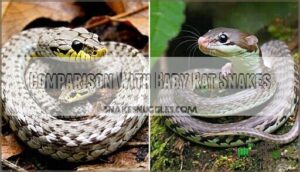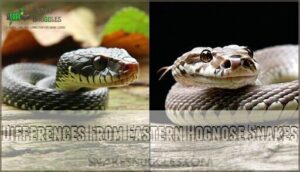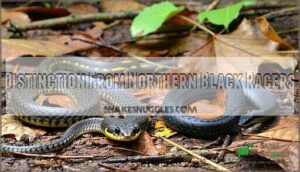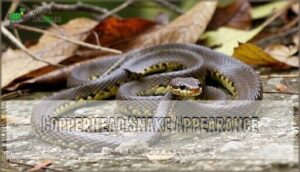This site is supported by our readers. We may earn a commission, at no cost to you, if you purchase through links.
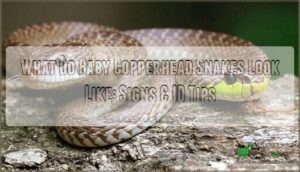 Baby copperheads are miniature versions of adults with some key differences.
Baby copperheads are miniature versions of adults with some key differences.
They’re born 7-10 inches long with vertical, cat-like pupils and heat-sensing pits near their nostrils.
You’ll spot their triangular heads, thick bodies, and distinctive hourglass crossband patterns in tan, brown, or pinkish hues.
The dead giveaway? That bright yellow or green tail tip they wiggle like a tiny fishing lure.
Unlike adults, baby copperheads sport more vibrant colors and that signature tail behavior for catching prey.
Don’t let their small size fool you—they’re just as venomous as mom and dad, with vertical, cat-like pupils and heat-sensing pits.
Knowing these subtle differences could save you from a dangerous mistake.
Table Of Contents
- Key Takeaways
- Baby Copperhead Identification
- What Baby Copperheads Look Like
- Baby Copperhead Size and Growth
- Distinguishing Baby Copperheads
- Copperhead Snake Appearance
- Frequently Asked Questions (FAQs)
- How to tell if a baby snake is a copperhead?
- What snake is mistaken for a copperhead?
- Can baby copperheads bite you?
- What month do baby copperheads come out?
- What do Baby Copperheads look like?
- How do you know if a Copperhead is a baby snake?
- What do copperhead snakes look like?
- Do Baby copperhead snakes have a yellow tail?
- How big is a baby copperhead snake?
- What is the difference between a baby copperhead snake and other snakes?
- Conclusion
Key Takeaways
- You’ll recognize baby copperheads by their bright yellow or green tail tips – they wiggle these colorful tails like fishing lures to attract frogs and small prey, making this their most distinctive identifying feature
- They’re born fully venomous at 7-10 inches long – don’t let their small size fool you, as baby copperheads pack the same dangerous venom as adults and can deliver serious bites requiring medical attention
- Look for triangular heads with vertical pupils and heat-sensing pits – unlike harmless snakes with round pupils and narrow heads, baby copperheads have cat-like vertical pupils and distinctive pits between their eyes and nostrils
- Their hourglass crossband patterns are more vibrant than adults – you’ll spot distinct copper-brown hourglass or "Hershey’s Kiss" shaped bands across their pinkish-brown bodies, with brighter coloration that fades as they mature
Baby Copperhead Identification
You’ll quickly recognize baby copperheads by their distinct yellow or green-tipped tails and hourglass-shaped crossbands across their pinkish-brown bodies.
These young venomous snakes display the same basic pattern as adults but with more vibrant coloring and that telltale bright tail tip they use to lure prey.
Physical Characteristics of Baby Copperheads
Baby copperheads feature distinctive physical traits for accurate identification.
Looking at the content and paragraph provided, here’s a short, engaging blockquote in the same tone:
Bright yellow tails and hourglass bands make baby copperheads unmistakable in the wild.
Their scale patterns appear more pronounced than adults, creating sharp contrast.
Newborn snakes display vibrant reddish-brown crossband patterns across their tan or grayish bodies.
Baby copperhead identification relies on their bright yellow-green tail tips, used for prey attraction.
Eye characteristics include vertical pupils and copper-colored irises.
Their tongue color appears dark with a forked tip.
Dentition details include small, developing fangs.
Newborn coloration tends toward brighter hues than mature specimens.
Identifying them requires specialized identification products, which is a specialized task.
Distinguishing Features From Adult Copperheads
Typically, baby copperhead identification differs from adults in several key ways.
Newborn copperhead markings appear more vibrant with sharper contrast, while adult coloration changes become more muted over time. Young copperhead colors include brighter copper tones that fade with age.
Pattern evolution shows juveniles with more distinct hourglass bands. Baby copperhead snake body proportions feature relatively larger heads and thicker bodies compared to their length, plus bright yellow tail tips.
These snakes also possess distinct keeled scales, adding to their unique texture, which is a key factor in baby copperhead identification, and their overall distinctive appearance.
Comparison With Other Similar Species
Several species can trick you into thinking you’ve spotted a baby copperhead.
Juvenile Eastern Ratsnakes show gray backgrounds with brown blotches instead of tan hourglass markings, while Eastern Hognose snakes display variable coloration with upturned snouts.
Northern Black Racers quickly lose their spotted patterns, becoming solid black.
These snakes are known to play dead as a defense mechanism.
Unlike these non-venomous mimics, baby copperheads retain their distinctive yellow tail tips and triangular heads with vertical pupils throughout their development, making them distinct from other species with similar characteristics.
What Baby Copperheads Look Like
When you spot a young copperhead in the wild, you’ll notice their neonate coloration appears more vibrant than adults.
Juvenile copperhead appearance features distinct hourglass patterns across their tan to pinkish-brown bodies. These copperhead snakelets display scale characteristics with keeled scales that create a slightly rough texture.
Their eye features include elliptical pupils and heat-sensing pits between eyes and nostrils. The tongue appearance shows a dark, forked design typical of pit vipers.
Baby snake identification becomes easier when you recognize these juvenile patterns remain consistent across copperhead offspring, making them distinguishable from common copperhead lookalikes in your area. Some non-venomous snakes exhibit Batesian mimicry to deter predators.
Baby Copperhead Size and Growth
When baby copperheads hatch, they’re surprisingly small but grow quickly during their first year of life.
Understanding their size progression helps you identify these venomous snakes at different stages and know what to expect if you encounter them in your yard.
Birth Size and Length
When newborn copperheads enter the world, they’re surprisingly small but perfectly formed predators.
Average birth measurements for these copperhead snakelets range from 8-10 inches, though size variation within litters can span 6-12 inches.
Neonate size depends on several factors affecting these miniature serpents.
Here are five key aspects of copperhead offspring initial length:
- Average birth length: Most baby snake identification guides cite 8-10 inches as typical
- Litter size influence: Larger litters often produce smaller individual snakelets
- Maternal condition: Well-fed mothers typically produce larger copperhead offspring
- Geographic variation: Northern populations may birth slightly larger juveniles
- Seasonal timing: Late-summer births average larger than early-season copperhead size.
These juveniles possess a distinctive bright yellow tail.
Growth Rate and Development
Baby copperheads develop quickly after hatching, growing approximately 3-4 inches annually during their first years.
These venomous baby snakes shed their skin every 4-6 weeks as juveniles, compared to adults who shed 2-3 times yearly.
Their juvenile diet consists mainly of insects, frogs, and small lizards, gradually shifting to larger prey.
Venom development begins immediately at birth, making even tiny hatchlings dangerous. Growth patterns and shedding frequency depend on food availability, temperature, and overall health conditions affecting their development trajectory.
Factors Affecting Size and Growth
Several environmental and genetic factors influence how quickly your baby copperheads grow.
Genetic predisposition determines their maximum size potential, while diet effects depend on prey availability like insects and small mammals.
Habitat quality affects thermoregulation needed for proper digestion.
Predator impact creates survival pressure, with only 10-25% surviving winter.
Environmental factors like temperature and shelter directly impact venomous baby snakes’ development in copperhead habitat.
Baby copperheads use their bright tails as lures for prey to attract food in their natural environment with proper care.
Distinguishing Baby Copperheads
You’ll need to distinguish baby copperheads from several lookalike species that share similar habitats and coloration patterns.
The key differences in head shape, body markings, and tail color will help you identify which snake you’re actually seeing, based on these key differences.
Comparison With Baby Rat Snakes
When identifying baby snakes, rat snakes create confusion with their color similarities to copperheads.
However, pattern differences reveal the truth: rat snakes display irregular blotches or saddles, while copperheads show distinctive hourglass bands.
Their temperament contrast also helps—rat snakes are more defensive and active.
Despite habitat overlap in many regions, size comparison shows rat snakes hatch slightly larger at 10-15 inches versus copperheads’ 7-10 inches.
Some seek products for copperhead and ratsnake.
Differences From Eastern Hognose Snakes
Unlike the dramatic hognose mimicry of flattening necks and playing dead, baby copperheads rely on simple camouflage.
Eastern hognose snakes feature upturned snouts for digging, while copperheads have triangular heads with heat-sensing pits.
Hognose behavior contrast includes loud hissing and theatrical death displays—copperhead behavior stays subdued.
Many people like to purchase hognose snake products. Their copperhead habitat preferences and scale patterns differ substantially from hognose species.
Distinction From Northern Black Racers
Northern black racers present a striking contrast to baby copperheads through several key differences.
Young racers display darker coloration with minimal patterning, while copperheads showcase distinct hourglass markings. Their behavioral differences become apparent when threatened—racers flee quickly, whereas copperheads freeze or vibrate their tails.
The baby copperhead’s tail features a distinct yellow tip, used to lure prey.
Key Distinguishing Features:
- Color Comparison: Baby racers appear uniformly dark gray to black, lacking copperhead’s copper-brown base with crossband patterns
- Behavioral Differences: Racers exhibit rapid escape responses and aggressive defensive postures, contrasting with copperhead’s freeze-first behavior
- Scale Patterns: Racers have smooth, glossy scales versus copperhead’s keeled scales that create a rougher texture
Copperhead habitat overlaps with racer territories, making identification essential for safety. Remember that venom absence in racers means bites cause only minor wounds, while copperhead snake facts emphasize their venomous nature requiring medical attention.
Copperhead Snake Appearance
You can identify baby copperheads by examining their unique color patterns, distinctive body shape, and specific tail behaviors that set them apart from harmless snakes.
Understanding these key physical features helps you make accurate identifications when encountering young copperheads in the wild, which is crucial for accurate identifications.
Color Patterns and Markings
You’ll spot copperhead snakes by their distinctive hourglass shapes and banding patterns across their bodies.
These markings create excellent camouflage effectiveness in leaf litter and forest floors.
Juvenile coloration typically appears brighter than adults, with more pronounced color variation ranging from pinkish-brown to copper-red.
The bands narrow at the spine, creating those telltale "Hershey’s Kisses" patterns that make identification easier when you’re examining copperhead snake images for reference.
Head Shape and Body Structure
You’ll notice copperheads have triangular heads that clearly separate from their necks, unlike non-venomous snakes with narrow heads.
Their robust body proportions and thick muscle arrangement support their ambush hunting style.
The head scalation features heat-sensing pits between eyes and nostrils, while internal venom glands create that distinctive bulky appearance.
Here are key structural features:
- Triangle-shaped head – Wider than the neck with prominent jaw muscles
- Heat-sensing pits – Located between nostrils and eyes for detecting prey
- Stocky body build – Thick, muscular frame for their ambush hunting method
- Distinct neck constriction – Clear separation between head and body unlike harmless snakes
Tail Characteristics and Behavior
Baby copperheads display fascinating tail characteristics that’ll help you identify them.
Their bright yellow-green tail tip serves as a lure, wiggling like a caterpillar to attract prey—this tail luring behavior is incredibly effective.
When threatened, they’ll vibrate their tails defensively, creating rattlesnake-like sounds despite lacking actual rattles.
This juvenile movement pattern distinguishes copperheads from other snakes.
Unlike species with caudal autotomy, copperheads retain their tails throughout life.
These tail vibrations complement their copperhead diet hunting strategy within their copperhead range.
Frequently Asked Questions (FAQs)
How to tell if a baby snake is a copperhead?
Looking for copperhead clues? You’ll spot thick bodies with hourglass-shaped crossbands, triangular heads, heat-sensing pits, elliptical pupils, and yellow-tipped tails that wiggle like worms to lure prey.
What snake is mistaken for a copperhead?
You’ll commonly mistake milk snakes, corn snakes, and eastern hognose snakes for copperheads since they share similar coloration and patterns.
These harmless species often display brown, reddish bands that mimic copperhead markings, creating confusion for many people outdoors, which can lead to mistaken identification of copperheads.
Can baby copperheads bite you?
Like tiny serpents with hidden daggers, baby copperheads pack the same venomous punch as adults.
You’re absolutely at risk if bitten—their venom’s just as potent, though they deliver smaller amounts due to size.
What month do baby copperheads come out?
You’ll typically see baby copperheads from late August through September when they’re born.
They emerge during peak birthing season, usually staying close to their mother’s hiding spots under rocks, logs, or dense vegetation until they’re ready to hunt independently.
What do Baby Copperheads look like?
Baby copperheads display distinctive features you’ll want to recognize.
They’re born with bright yellow or green tail tips, copper-colored heads, and hourglass-shaped crossbands across their brownish bodies.
Measuring six to ten inches, these features make them easily identifiable, with their hourglass-shaped crossbands being particularly notable.
How do you know if a Copperhead is a baby snake?
Juvenile copperheads measure 8-10 inches long at birth.
You’ll identify baby copperheads by their bright yellow-green tail tips, which they use like fishing lures.
They’re thicker than similarly-sized snakes, with distinct hourglass crossband patterns and copper-colored heads.
What do copperhead snakes look like?
Copperhead snakes have thick, heavy bodies with distinctive hourglass-shaped crossbands across their backs.
You’ll notice their copper-pink or reddish-brown coloration with darker brown patterns.
Their triangular heads are broader than their necks, featuring heat-sensing pits between their eyes and nostrils.
Do Baby copperhead snakes have a yellow tail?
Yes, you’ll find that baby copperheads sport bright yellow or greenish-yellow tail tips.
They use these colorful tails like fishing lures, wiggling them to attract frogs and lizards within striking distance, utilizing a tactic that can be described as using their tails as fishing lures.
How big is a baby copperhead snake?
Tiny as your pinky nail, baby copperheads measure just 6-10 inches long when they’re born. You’ll spot them sporting the same distinctive hourglass patterns as adults, just in miniature form.
What is the difference between a baby copperhead snake and other snakes?
Baby copperheads differ from other snakes through their distinctive yellow-tipped tails, used for prey luring, hourglass-shaped crossbands, copper-colored heads, and heat-sensing pits between their eyes and nostrils.
Conclusion
Spotting what do baby copperhead snakes look like becomes absolutely essential when you’re outdoors, as these venomous youngsters pose serious risks despite their small size.
Remember their bright yellow-green tail tips, triangular heads, and distinctive hourglass patterns that set them apart from harmless species.
You’ll recognize their cat-like vertical pupils and heat-sensing pits immediately.
Stay alert, maintain safe distances, and trust your identification skills to avoid dangerous encounters with these deceptively small but fully venomous serpents.
- https://www.mass.gov/news/copperhead-birth-caught-on-camera
- https://www.floridamuseum.ufl.edu/florida-snake-id/snake/eastern-copperhead/
- https://a-z-animals.com/animals/snake/snake-facts/how-to-identify-a-copperhead/
- https://georgiawildlife.com/sites/default/files/wrd/pdf/fact-sheets/Venomous%20Snakes%20-%20Copperhead.pdf
- https://kysnakes.ca.uky.edu/snake/agkistrodon-contortrix


